iKnife Collector
The online community of knife collectors, A Knife Family Forged in Steel
So..... I guess I'll start with a review. :D
So finally a friend and I have acquired a good assortment of medium sized fix blades to test.
The test is broken down in to 2 categories: Use and Comfort.
Then those two categories are broken down into several sub categories: fuzz/curl making, batonning, chopping, and drilling.
Ratings will be given to comfort during all these task. This is a very limited view as we are only gauging initial comfort during use. We are not measuring how comfortable the knife is after prolong use.
This is a simple test that includes some of the most vital tasks for survival/bushcraft. Of course, it is not limited to just these four.
So on to the test.
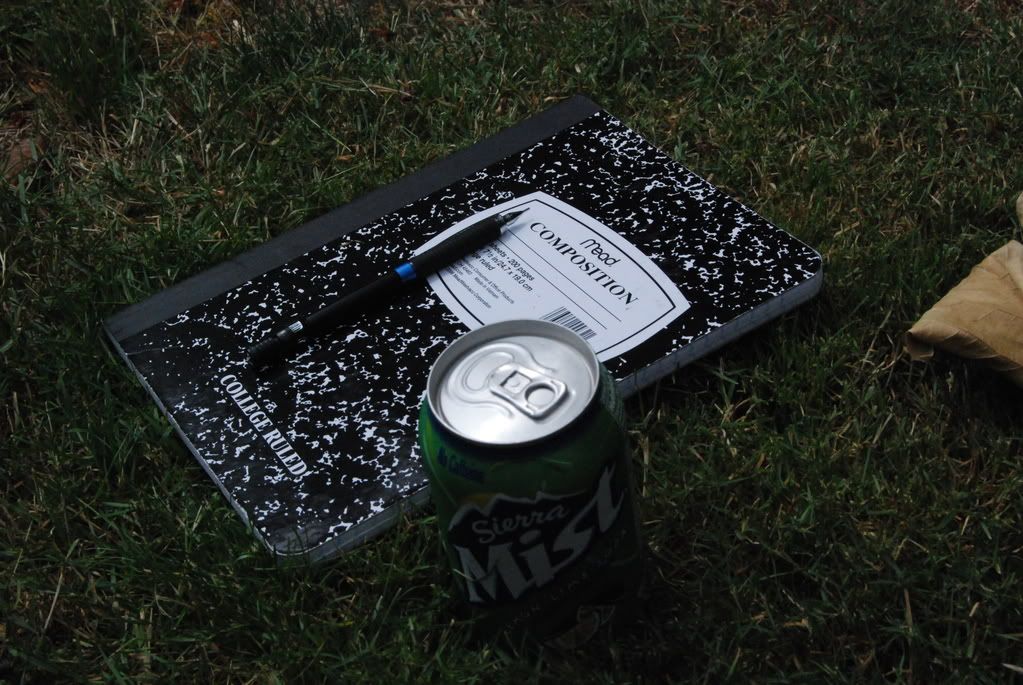
(note: not all of these have pictures of the individual knives and task.)
So here are the contestants.
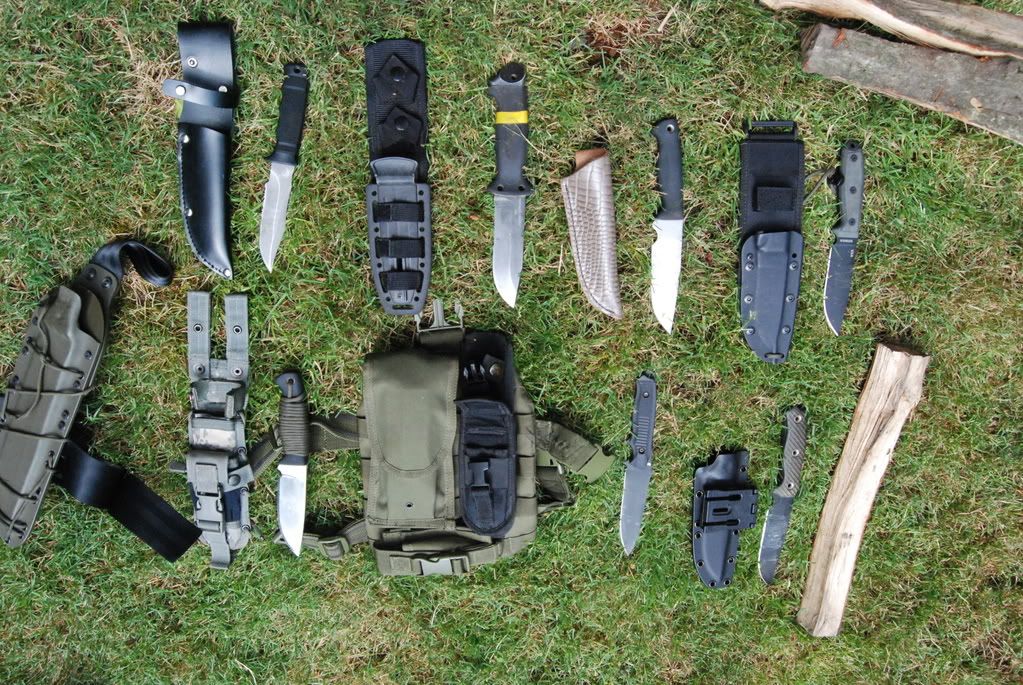
RC-4
DMDC
LMF II
SOG
YKLE
Nimravus
RMD
For refreshments, we had the unfortunate happening that we are only 17, and thus drinks were non-alcoholic. :D

Fuzz/curl Making
This is how the curls were made. The basic set-up is a piece of wood secured under my quads and behind the knee joint. The curls were made with one hand choked up on the handle and one knife on the spine near the tip or mid blade.
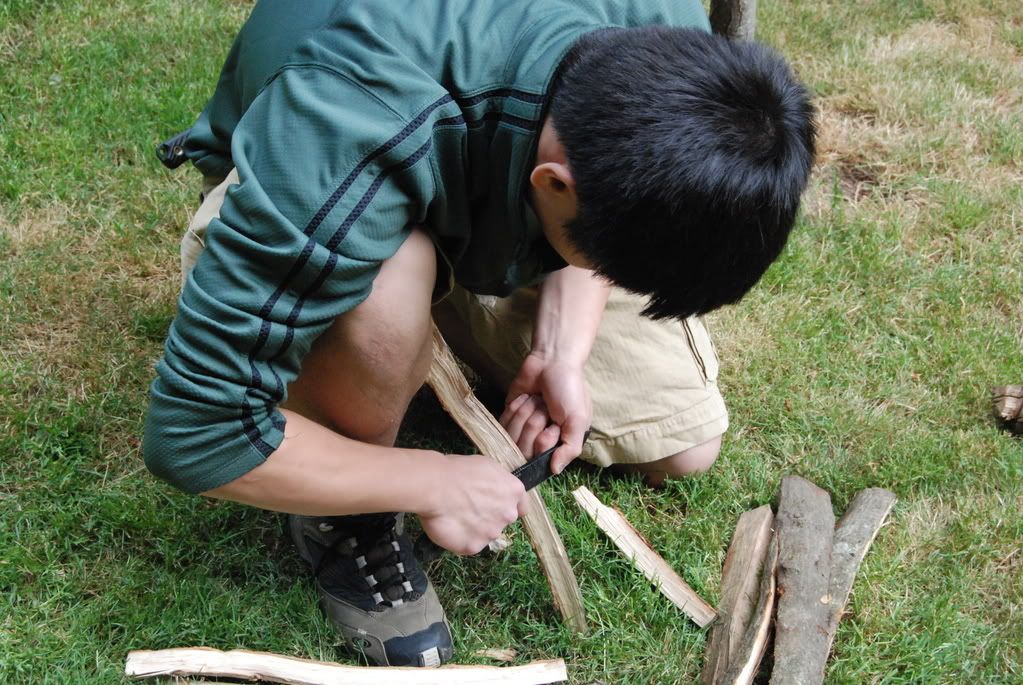
RC-4: Produced fine curls with little loss of curls. The choil on this was a bit too small to be helpful.
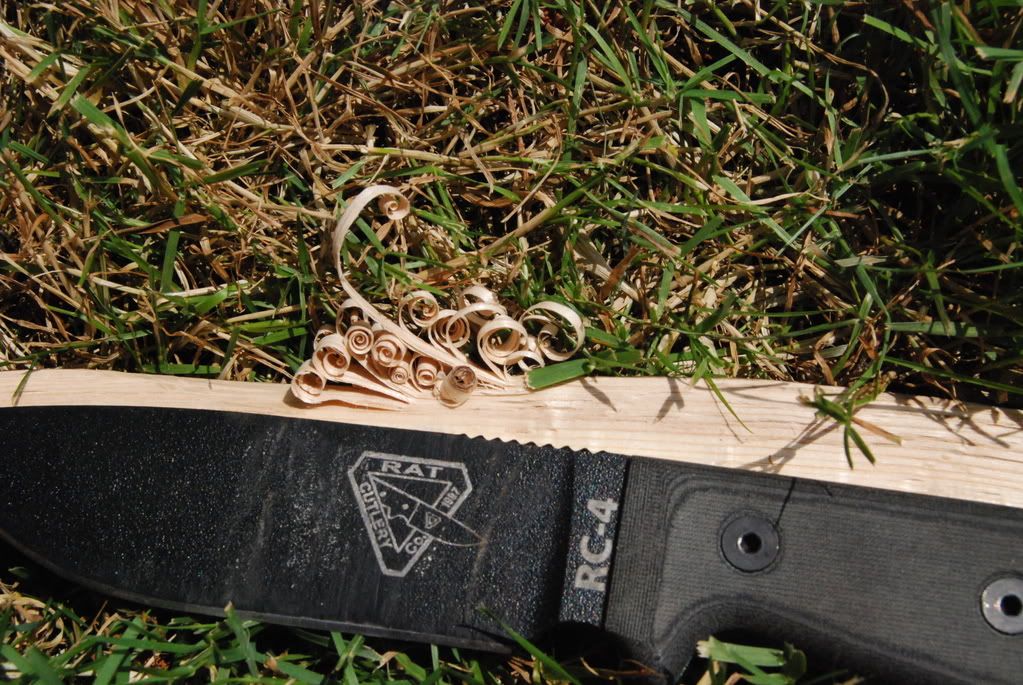
DMDC: Almost as fine curls as RC-4, however there was a little more loss of curls due to higher grind and thicker blade. The choil works well for this task.
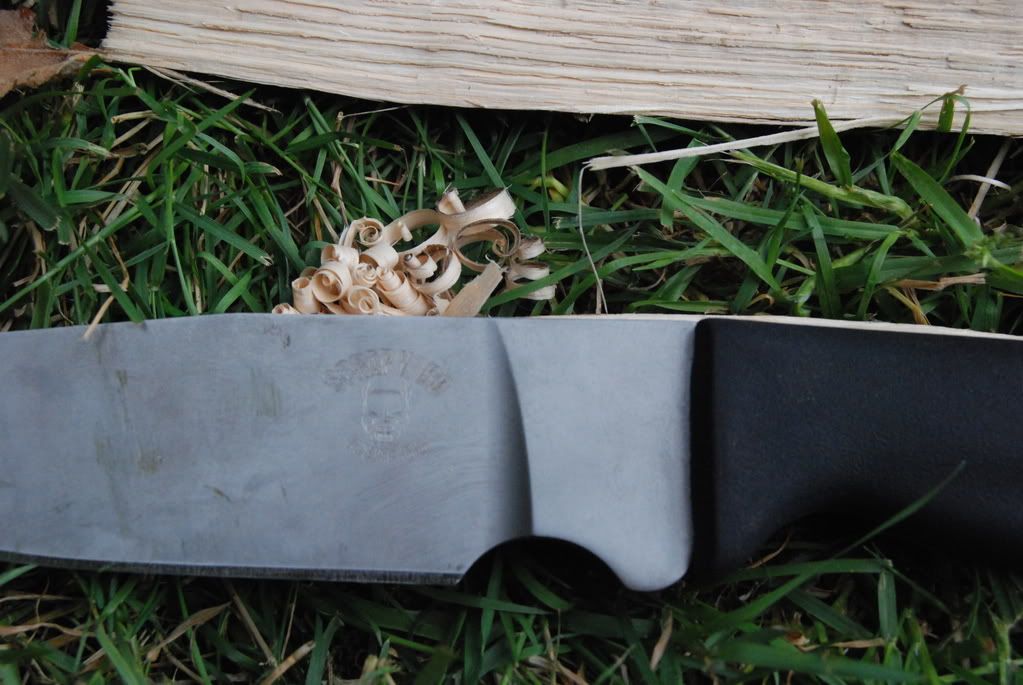
LMF-II: Very coarse curls with plain edge (as if they were about to break), quite a good amount of curls lost. Serrated edge created very fat thick cuts, no loss. The large handle was comfortable for slicing. The knife was not sharp and does not take a good edge.
Plain portion
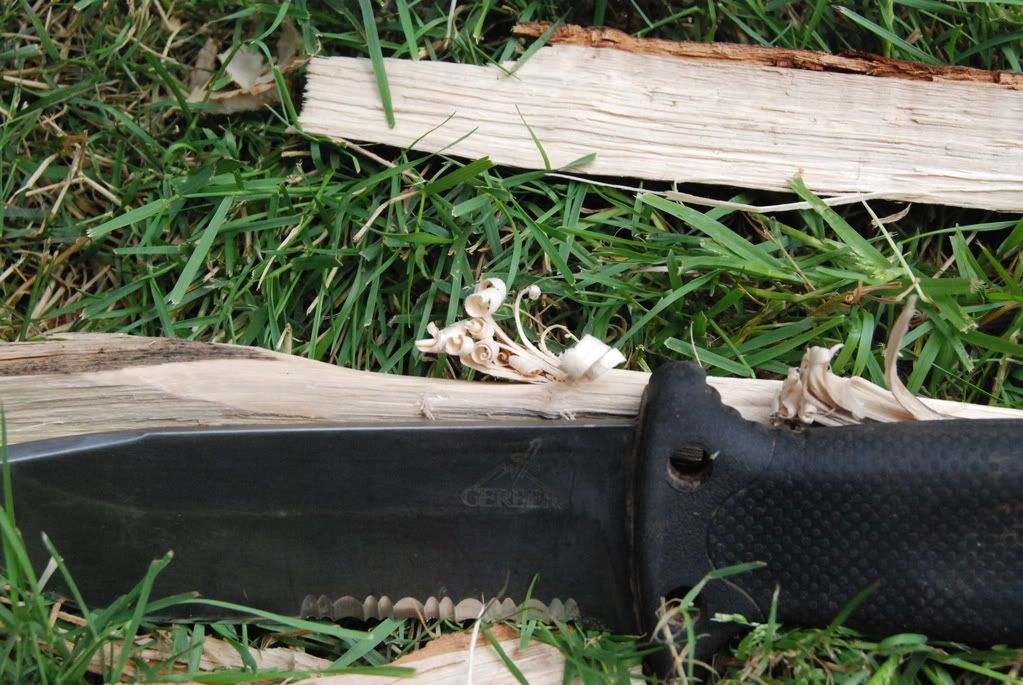
Serrated Portion
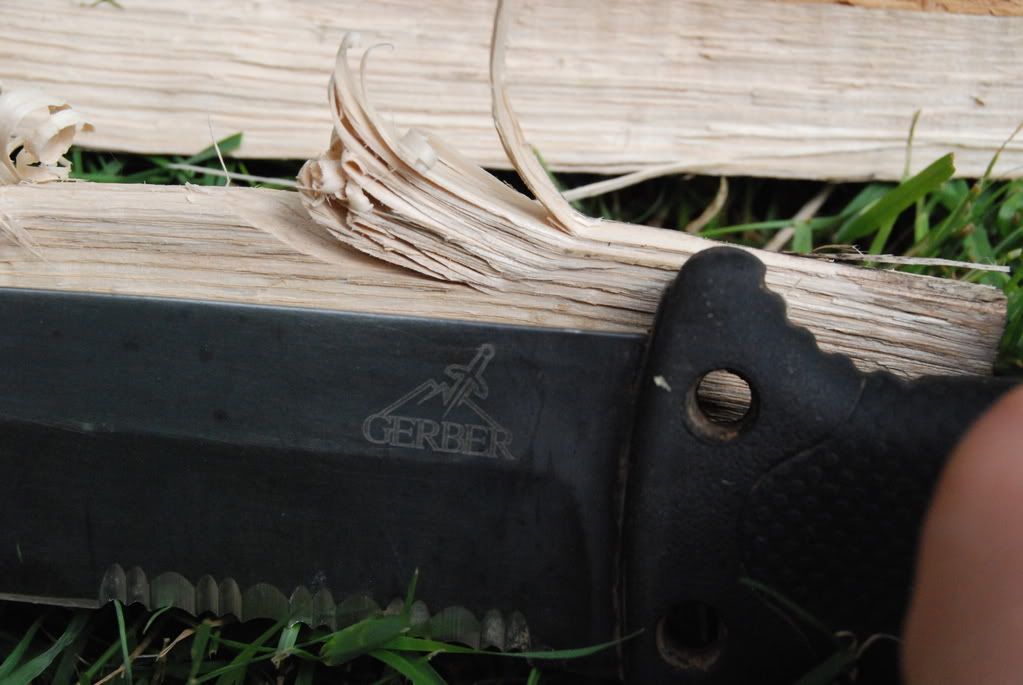
SOG: Decent curls with plain edge, but with some loss of curls. Better curls with the serrated edge, very little loss, but still not as good as the DMDC or RC-4. Handles were extremely uncomfortable
Left is plain portion, right is serrated portion.
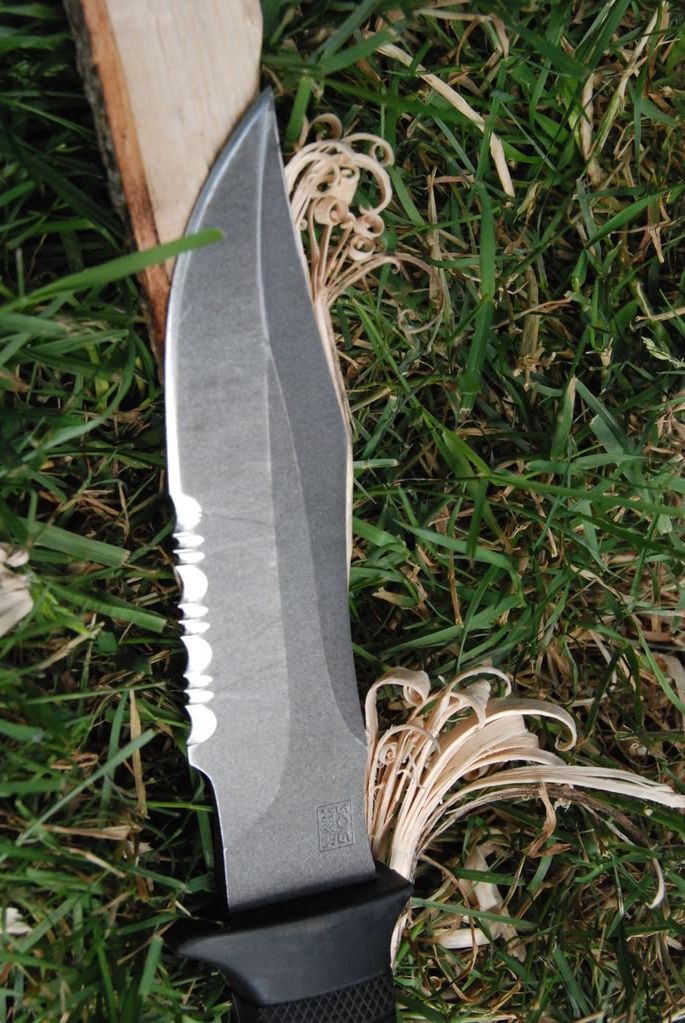
YKLE: Very good curls that rolled up very tightly, probably due to this being the sharpest knife. The knife was not this sharp from the factory. Little curls were lost. The Paracord handles created more hotspots than no paracord.

Nimravus: Very thin blade allowed for some long thin curls that held very well. Not as tightly bound as the YK but slices effortlessly. Probably the best curls for burning. Very little loss of curls. This knife is the most similar to a Scandinavian-ground bushcraft knife, and is probably the best slicer of the bunch.
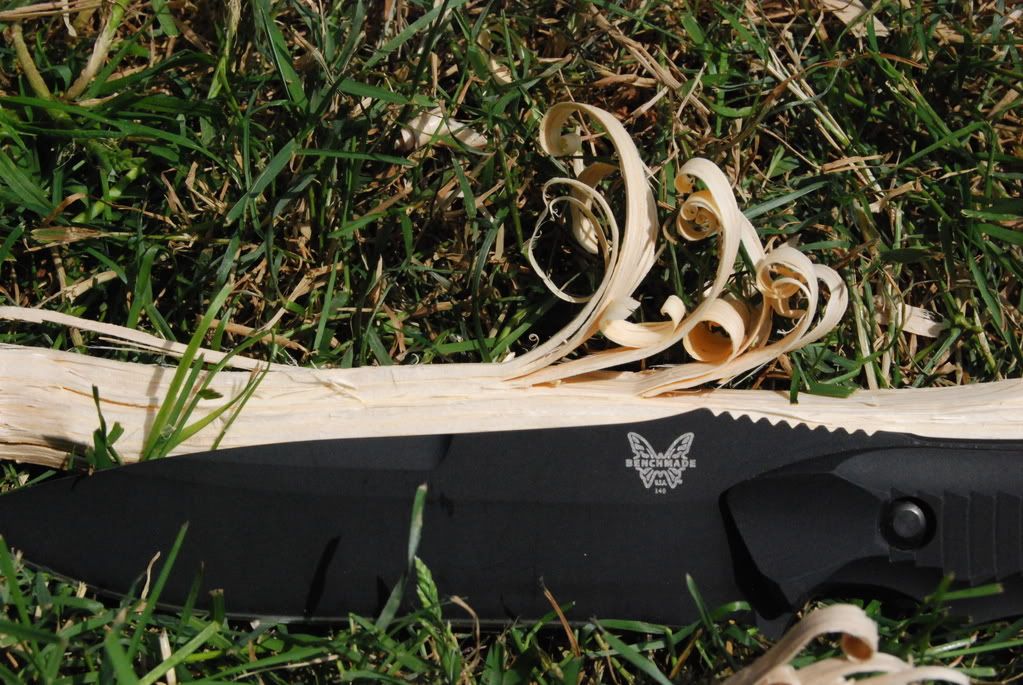
RMD: Curls very similar to Nimravus, however, harder time pushing knife through the wood. There was definitely some loss of curls. This knife was not as sharp as others like the RC-4, but was about as sharp as it came from the factory.
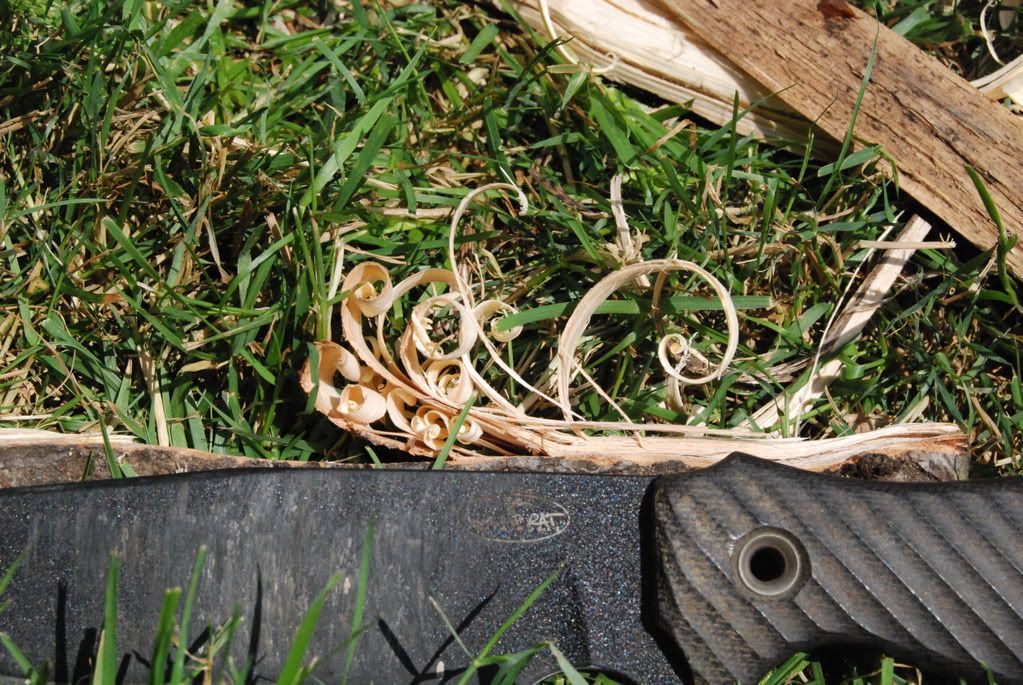
Batonning
The batonning was done while kneeling.
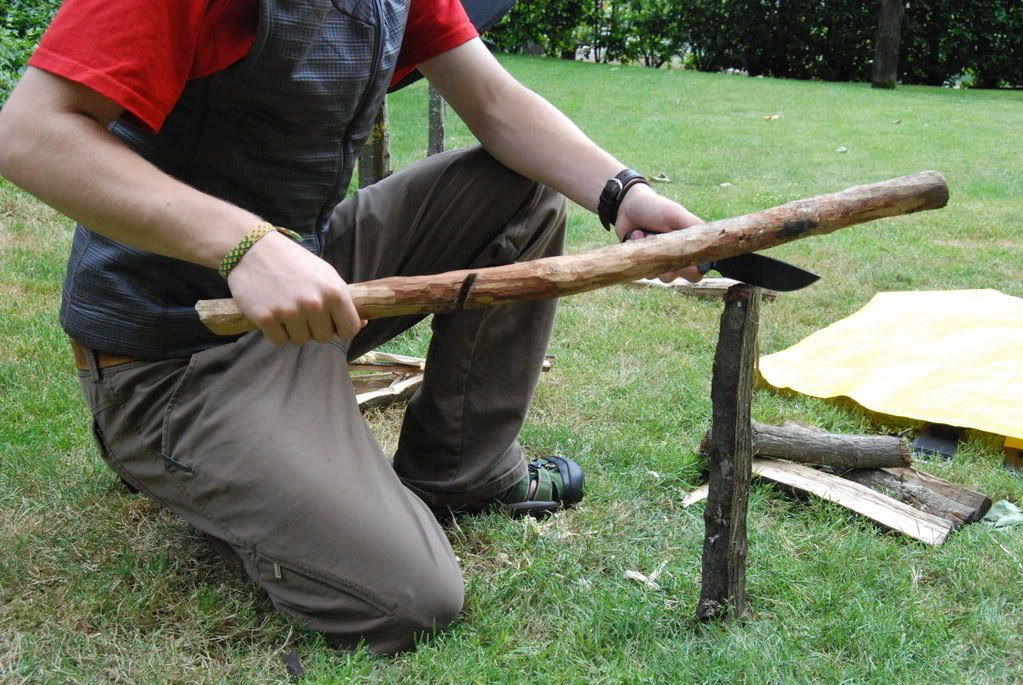
Here are some action shots.
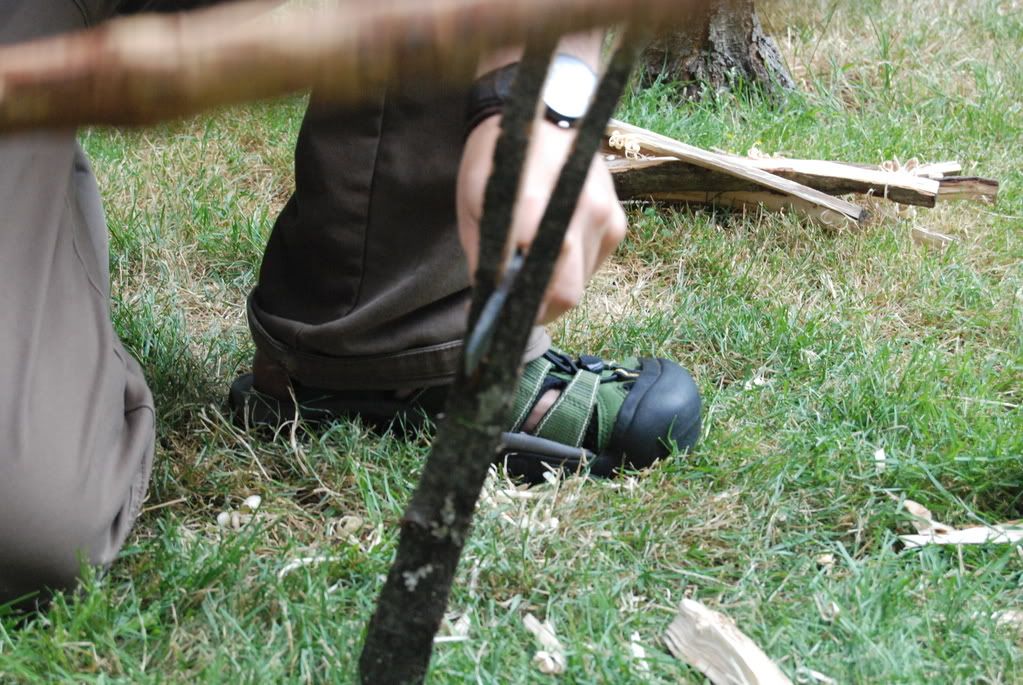
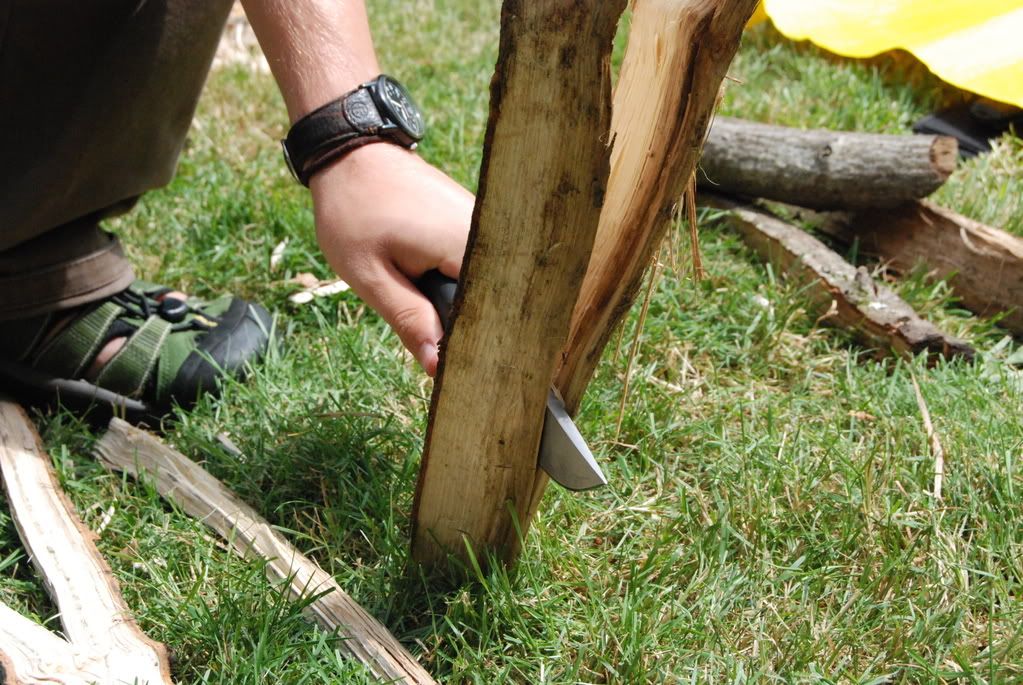
RC-4: The new crinkle coat smoothes quickly. The knife splits slowly but the handle is very comfortable, but a bit short.
DMDC: With the double cut finish, you don’t need to worry about coating loss. The knife splits well but the RES-C handles were not very comfortable for this task. Because the handles were too short, the thick hilt bashed into my palm. Very secure though, no slippage
LMF-II: The saber grind on this knife helped to make it the best batonner. The saber grind splits faster because of the higher grind angle and the reduced friction on the wood. The very long handle on this knife helped to keep the blade perpendicular to the wood. The rubber handles were comfortable, but might blister after long use. Serration teeth might also be damaged after long use.
SOG: Tied for worst in this category, the SOG was inferior in every regard. The knife split slowly and the checked handles rip up your palm. Furthermore, the swedge destroys your batoning log much more quickly than other knives. Same serration tip concerns as LMF.
The baton from the SOG.
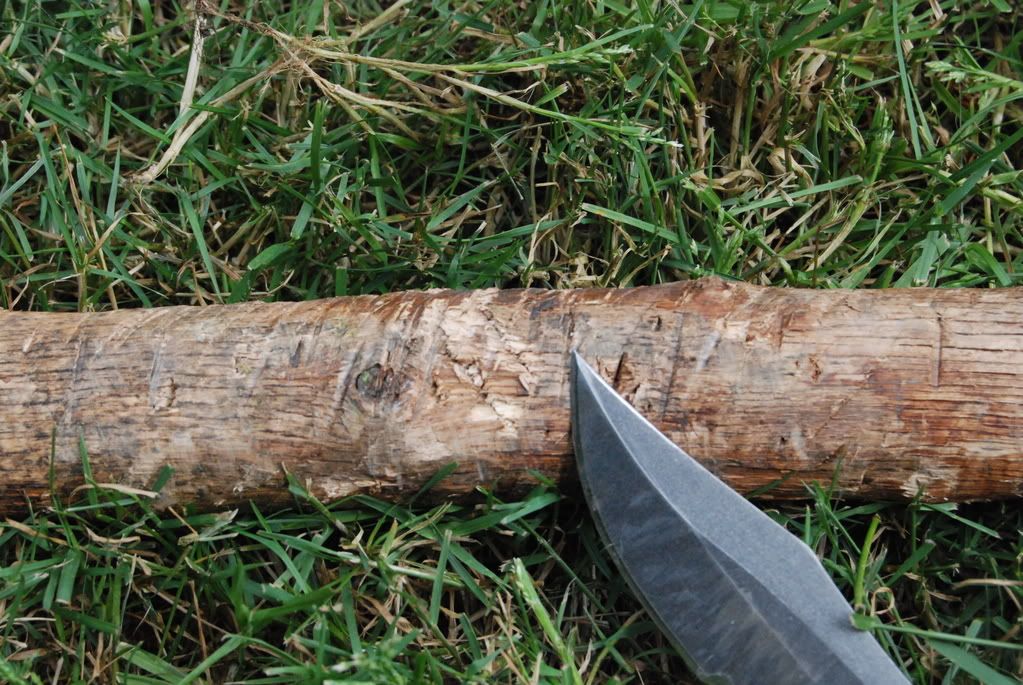
The baton from other knife use.

(baton made from oak)
YKLE: This knife experienced the same problems as DMDC in terms of hilt discomfort. The knife was slightly too thick to work as well as the others, and also too short for most batonning. The paracord produced hot spots and did not help for this task.
Nimravus: Also tied for worst in this group, the Nimravus’ textured Aluminum handles also ripped up the handles. Also, the tang is not designed to be flush with the handles (it’s wider than the slabs), similar to the Chris Reeve Green Beret knife. This protruding tang was very comfortable and would absolutely wreck your hand. The knife was also too thin to split the wood quickly
RMD: Nearly as quick as the LMF, the saber grind zips through the wood. The long handle prevents the hilt issues that occurred with the RES-C handles. This is the second best knife in this category.
Chopping
RC-4: Created shallow bites but was very comfortable
DMDC: Created deep bites but the end of the handle caused extreme abrasion with the pinky, quickly creating the so-called “Busse Pinky”. After prolong use, the handles would get uncomfortable
LMF-II: The bites on this knife was either as deep as the DMDC or slightly deeper. Not too bad of a chopper. The handles would also have the same problem as the Res-C.
SOG: Most likely the worst chopper of the knives tested. Very shallow bites were created and the handles were extremely uncomfortable. The checkering digs very deep into the hands and an occasional slip caused the areas of the hand to sting. This was also the lightest knife.
YKLE: The created some medium bites. Not as good as the DMDC but not as bad as the RC-4. The nub at the bottom of the end of the handle created the same problem as the DMDC. The paracord handle was actually slightly more comfortable.
Nimravus: Almost as bad as the SOG in chopping. Very shallow bites along with deep bidirectional pattering of the aluminum handles make this one of the poorer choppers.
RMD: Created medium-deep bits. About as good as the knife was expected to perform.

The best choppers were the LMF II and the DMDC.

Drilling
RC-4: The knife worked fairly well with this, but the chunk of exposed steel at the butt of the knife made downward pressure uncomfortable.
DMDC: This tip created a large-bore hole and drilled fairly deeply. Because the handles had a cylindrical cross-section, the knife turned easier in the hand. However, the friction/stickiness of the RES-C would probably become uncomfortable over time.
LMF-II: The bites generated by this knife were almost as good as the DMDC, but the angular skull-crusher / hammer on the butt of the knife made it very difficult to drill with
SOG: For what its worth, this knife was our best drill – the rounded, hard plastic butt turned easily and comfortably in the hand. This still doesn’t make up for its abysmal failure in almost all other areas though. All the same, its drilling abilities are proof of the knife’s excellent penetration, but we would say that the Nimravus would be a better fighter.
YKLE: No different from the DMDC in terms of comfort, but the paracord did make this more comfortable. Given the fat point, this knife still drilled well and the wide belly made for a more even hole.
Nimravus: Because the knife would possibly lose its thin tip during this test, we didn’t attempt it. However, the pointed butt would probably be uncomfortable for drilling.
RMD: This knife fared slightly better than the RD-4, but still suffered the same issues with uncomfortable exposed metal on the butt.
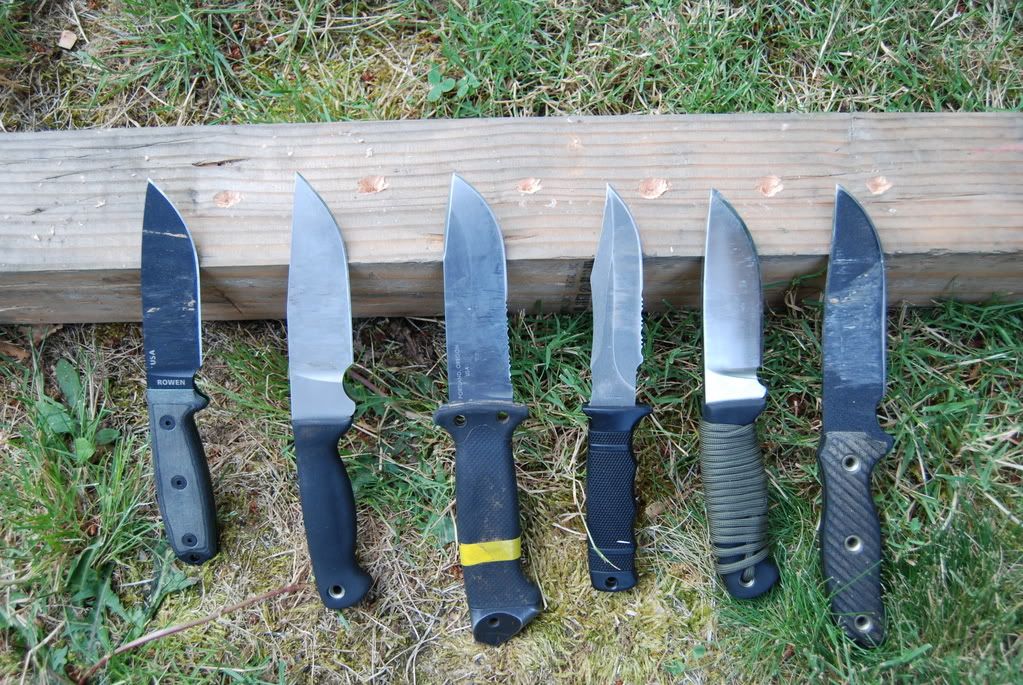
The best drillers were the DMDC and the SOG
Close up of DMDC
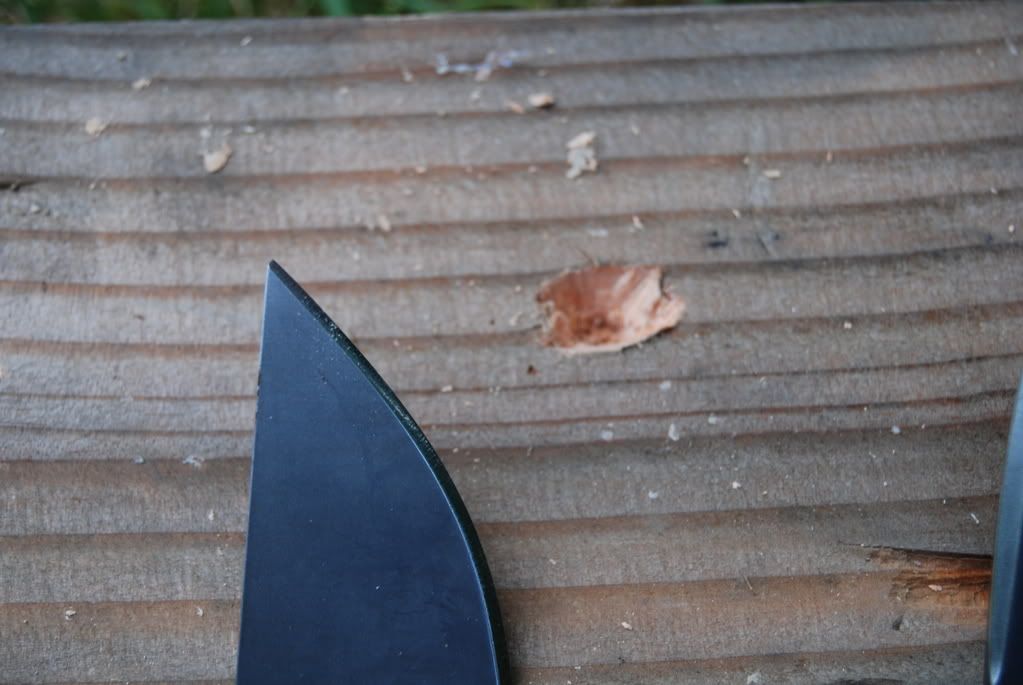
Close up of SOG
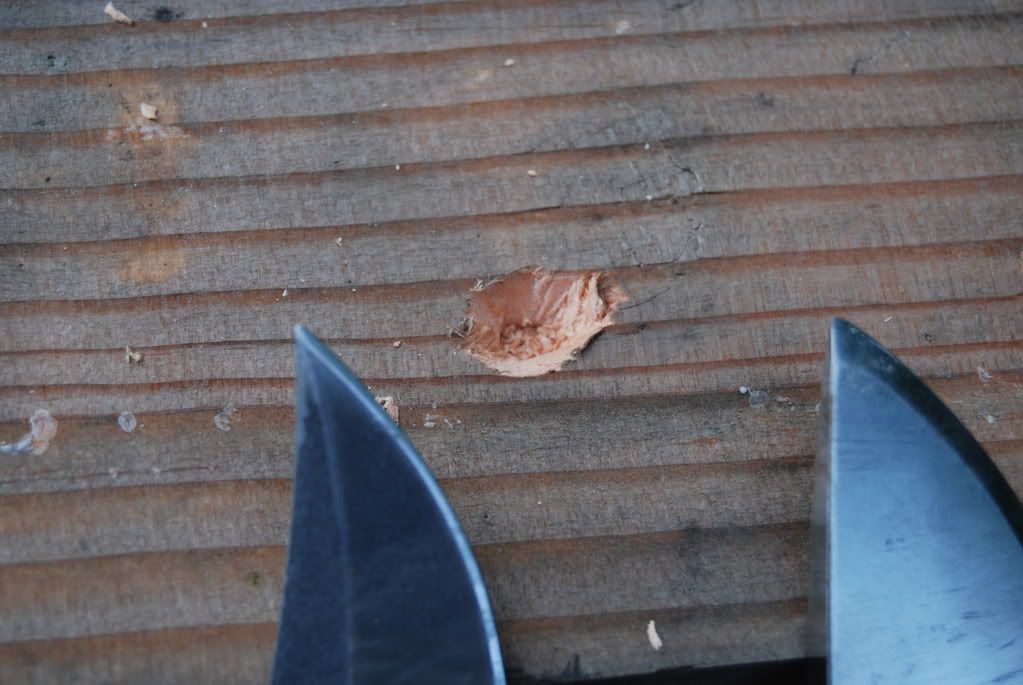
Comfort
Again, remember this is comfort from initial use. After one task is complete with one knife, the knife is swapped for another knife. The is not comfort from all the test with one knife all at once. With this said, the test after the first test might actually have a lower rating.
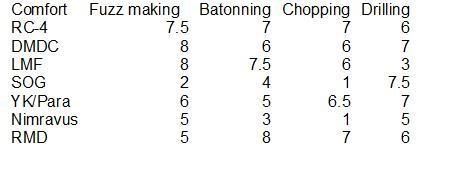
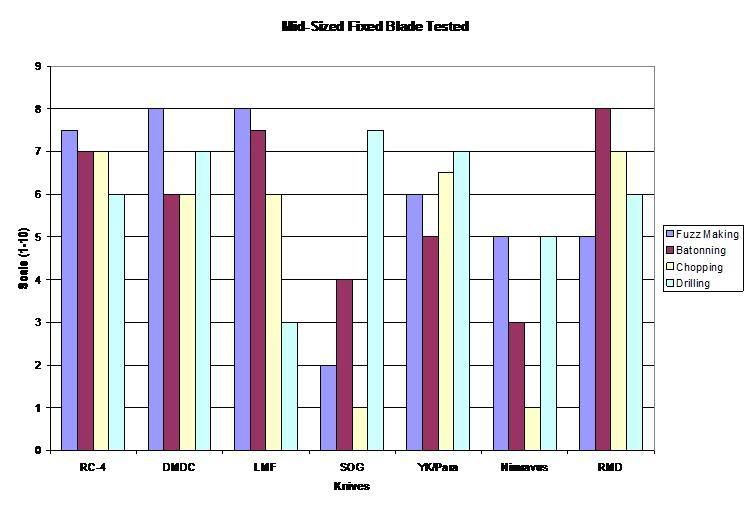
The test is broken down in to 2 categories: Use and Comfort.
Then those two categories are broken down into several sub categories: fuzz/curl making, batonning, chopping, and drilling.
Ratings will be given to comfort during all these task. This is a very limited view as we are only gauging initial comfort during use. We are not measuring how comfortable the knife is after prolong use.
This is a simple test that includes some of the most vital tasks for survival/bushcraft. Of course, it is not limited to just these four.
So on to the test.

(note: not all of these have pictures of the individual knives and task.)
So here are the contestants.

RC-4
DMDC
LMF II
SOG
YKLE
Nimravus
RMD
For refreshments, we had the unfortunate happening that we are only 17, and thus drinks were non-alcoholic. :D

Fuzz/curl Making
This is how the curls were made. The basic set-up is a piece of wood secured under my quads and behind the knee joint. The curls were made with one hand choked up on the handle and one knife on the spine near the tip or mid blade.

RC-4: Produced fine curls with little loss of curls. The choil on this was a bit too small to be helpful.

DMDC: Almost as fine curls as RC-4, however there was a little more loss of curls due to higher grind and thicker blade. The choil works well for this task.

LMF-II: Very coarse curls with plain edge (as if they were about to break), quite a good amount of curls lost. Serrated edge created very fat thick cuts, no loss. The large handle was comfortable for slicing. The knife was not sharp and does not take a good edge.
Plain portion

Serrated Portion

SOG: Decent curls with plain edge, but with some loss of curls. Better curls with the serrated edge, very little loss, but still not as good as the DMDC or RC-4. Handles were extremely uncomfortable
Left is plain portion, right is serrated portion.

YKLE: Very good curls that rolled up very tightly, probably due to this being the sharpest knife. The knife was not this sharp from the factory. Little curls were lost. The Paracord handles created more hotspots than no paracord.

Nimravus: Very thin blade allowed for some long thin curls that held very well. Not as tightly bound as the YK but slices effortlessly. Probably the best curls for burning. Very little loss of curls. This knife is the most similar to a Scandinavian-ground bushcraft knife, and is probably the best slicer of the bunch.

RMD: Curls very similar to Nimravus, however, harder time pushing knife through the wood. There was definitely some loss of curls. This knife was not as sharp as others like the RC-4, but was about as sharp as it came from the factory.

Batonning
The batonning was done while kneeling.

Here are some action shots.


RC-4: The new crinkle coat smoothes quickly. The knife splits slowly but the handle is very comfortable, but a bit short.
DMDC: With the double cut finish, you don’t need to worry about coating loss. The knife splits well but the RES-C handles were not very comfortable for this task. Because the handles were too short, the thick hilt bashed into my palm. Very secure though, no slippage
LMF-II: The saber grind on this knife helped to make it the best batonner. The saber grind splits faster because of the higher grind angle and the reduced friction on the wood. The very long handle on this knife helped to keep the blade perpendicular to the wood. The rubber handles were comfortable, but might blister after long use. Serration teeth might also be damaged after long use.
SOG: Tied for worst in this category, the SOG was inferior in every regard. The knife split slowly and the checked handles rip up your palm. Furthermore, the swedge destroys your batoning log much more quickly than other knives. Same serration tip concerns as LMF.
The baton from the SOG.

The baton from other knife use.

(baton made from oak)
YKLE: This knife experienced the same problems as DMDC in terms of hilt discomfort. The knife was slightly too thick to work as well as the others, and also too short for most batonning. The paracord produced hot spots and did not help for this task.
Nimravus: Also tied for worst in this group, the Nimravus’ textured Aluminum handles also ripped up the handles. Also, the tang is not designed to be flush with the handles (it’s wider than the slabs), similar to the Chris Reeve Green Beret knife. This protruding tang was very comfortable and would absolutely wreck your hand. The knife was also too thin to split the wood quickly
RMD: Nearly as quick as the LMF, the saber grind zips through the wood. The long handle prevents the hilt issues that occurred with the RES-C handles. This is the second best knife in this category.
Chopping
RC-4: Created shallow bites but was very comfortable
DMDC: Created deep bites but the end of the handle caused extreme abrasion with the pinky, quickly creating the so-called “Busse Pinky”. After prolong use, the handles would get uncomfortable
LMF-II: The bites on this knife was either as deep as the DMDC or slightly deeper. Not too bad of a chopper. The handles would also have the same problem as the Res-C.
SOG: Most likely the worst chopper of the knives tested. Very shallow bites were created and the handles were extremely uncomfortable. The checkering digs very deep into the hands and an occasional slip caused the areas of the hand to sting. This was also the lightest knife.
YKLE: The created some medium bites. Not as good as the DMDC but not as bad as the RC-4. The nub at the bottom of the end of the handle created the same problem as the DMDC. The paracord handle was actually slightly more comfortable.
Nimravus: Almost as bad as the SOG in chopping. Very shallow bites along with deep bidirectional pattering of the aluminum handles make this one of the poorer choppers.
RMD: Created medium-deep bits. About as good as the knife was expected to perform.

The best choppers were the LMF II and the DMDC.

Drilling
RC-4: The knife worked fairly well with this, but the chunk of exposed steel at the butt of the knife made downward pressure uncomfortable.
DMDC: This tip created a large-bore hole and drilled fairly deeply. Because the handles had a cylindrical cross-section, the knife turned easier in the hand. However, the friction/stickiness of the RES-C would probably become uncomfortable over time.
LMF-II: The bites generated by this knife were almost as good as the DMDC, but the angular skull-crusher / hammer on the butt of the knife made it very difficult to drill with
SOG: For what its worth, this knife was our best drill – the rounded, hard plastic butt turned easily and comfortably in the hand. This still doesn’t make up for its abysmal failure in almost all other areas though. All the same, its drilling abilities are proof of the knife’s excellent penetration, but we would say that the Nimravus would be a better fighter.
YKLE: No different from the DMDC in terms of comfort, but the paracord did make this more comfortable. Given the fat point, this knife still drilled well and the wide belly made for a more even hole.
Nimravus: Because the knife would possibly lose its thin tip during this test, we didn’t attempt it. However, the pointed butt would probably be uncomfortable for drilling.
RMD: This knife fared slightly better than the RD-4, but still suffered the same issues with uncomfortable exposed metal on the butt.

The best drillers were the DMDC and the SOG
Close up of DMDC

Close up of SOG

Comfort
Again, remember this is comfort from initial use. After one task is complete with one knife, the knife is swapped for another knife. The is not comfort from all the test with one knife all at once. With this said, the test after the first test might actually have a lower rating.


Add a Comment
-
Comment by Alden Rowe on May 14, 2009 at 22:42
-
Nice review, the graph is nice touch.
-
Comment by Tom Cai on May 1, 2009 at 9:39
-
I see, I should be using "<>" instead of "[]."
-
In Memoriam Comment by Scott King on May 1, 2009 at 9:31 -
Tom
No, it has worked for me each time I've tried. I try it right here now. If it didn't work then hopefully NING will jump on it.
-
Comment by Tom Cai on May 1, 2009 at 9:19
-
BTW.... I forgot to ask, does anyone know why the formatting code isn't working? The titles should be bold.
-
Comment by Tom Cai on May 1, 2009 at 9:17
-
Thanks for the kind compliments! This review was done a little while ago, but the both of use wanted to do a fairly long and thorough review of medium sized fixed blades. Since that's pretty much all we ever use in the woods. I'll have another of the RTAKII, if anyone is interested ( :D ), this one is very, very long. Last I remember it contained over 1000 words, might as well be an article in Blade Magazine. Hahahah....
Keelen,
The Rat Cutlery series are very good knives. They have great edge geometry and excellent tip strength (which many "good" knives lack). Hope you'll do a vid of the RC-6 in action.
Scott,
I actually don't own any of the classic trapper, railsplitter, whittler, trapper, etc. etc. style of knives. Though I am actually quite interested in those style of knives and, if I get one sometime in the future, I would definitely do a similar type of review. Though I would include more carving and whittling of wood. Personally, I really like the old classics with good steel, Schatt and Morgan (ATS-34) or Canal Street (D2).
-
In Memoriam Comment by Scott King on April 30, 2009 at 22:36 -
Tom
Very interesting. I am impressed with your approach and thoroughness. You photodocumented your review so we could follow you through the tests, which was extremely helpful and informative.
Have you ever done traditional pocket knives using the leading brands?
Great job.
Scott
-
Comment by Keelen Grimm on April 30, 2009 at 20:20
-
I must say you did an amazing job with this post! You were very thorough and in-depth. I was glad to see that the RC-4 preformed well because my RC-6 is a great knife and tackles whatever I though at it! Great job once again!
Latest Activity
Saturday
Saturday
Friday
© 2026 Created by Jan Carter.
Powered by
![]()
You need to be a member of iKnife Collector to add comments!
Join iKnife Collector